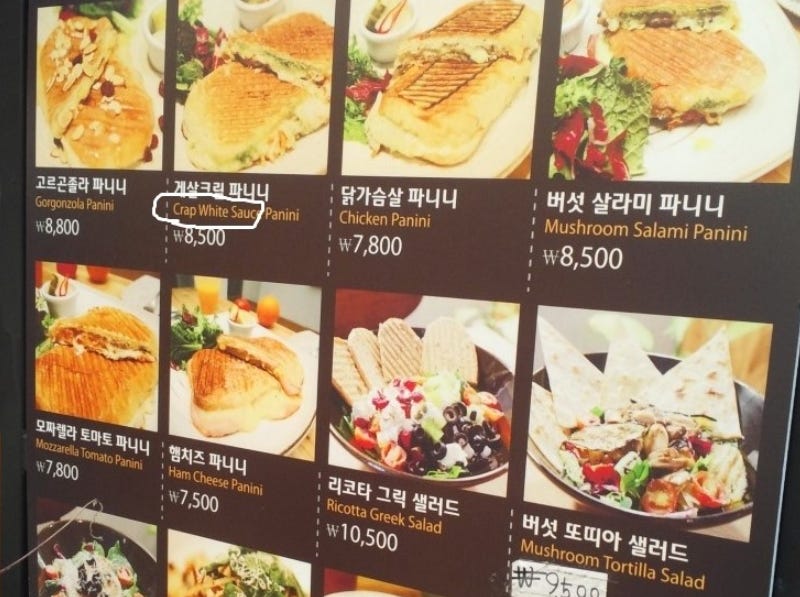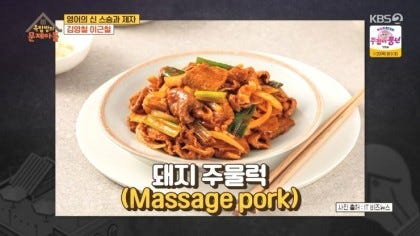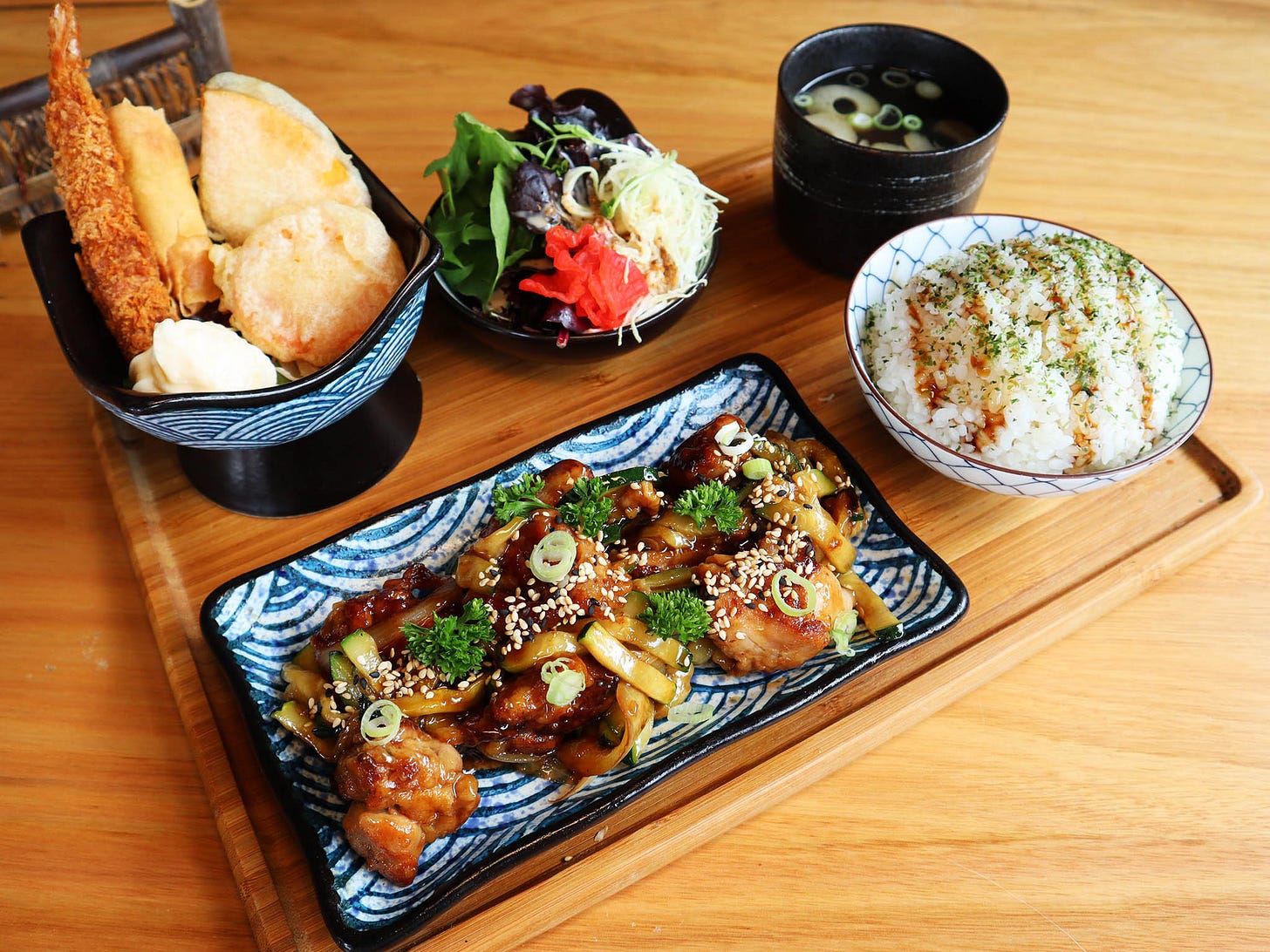It must’ve been the summer of 2015 when I took my 3 kids to Seoul for the first time since they were all born here in Los Angeles. We were walking in a trendy neighborhood called Garosu-gil (가로수길) in Gangnam area and purely by chance, we came across this.
The four of us had a hearty laugh that day, and after we came back to LA, I put this picture up on my Korean language blog that I had been writing.
Years ago, there was a campaign that the Korean tourism board, a government agency, ran to fix all the bad translations a lot of the small mom-and-pop restaurant owners had on their menu. And I got wind of it through my blog-writing in one of the main Korean portal websites, Naver. If anyone’s interested, here is the link.
I couldn’t believe what I was seeing back then. I couldn’t help laughing out loud as I kept seeing more and worse of these, and then I started worrying. Worrying about those restaurant owners, the government workers in trying to fix them, the image that this was going to portray to foreign visitors, and whether the translations were going to be done correctly.
Take, for example, this delicacy called Yook-hwae (육회).
육 (yook, 肉) is “meat” and 회 (hwae) is “food (usually fish) served raw.” And because this particular dish is always made with beef, this would be the “Korean style beef tartare or carpaccio.”
Do you remember from my last posting how to count to ten in Korean? What was 6? 육 (yook, 六), right? This was translated on the menu as…
Six times! Mmm… that sounds delicious…
How about this? One of the K-soul foods, sullung-tang (설렁탕), or gom-tang (곰탕). Different names, but essentially the same thing. If you refer back to my “Reading the Korean Menu” posting, you’ll know that anything -tang is some sort of soup.
Here, the problem was the word 곰. 99% of the time, the word by itself would mean “bear.” But, there is a verb “고다” which means “to boil something for a very long time to extract all essence out of the ingredient.” (FYI, this verb has very irregular conjugations, so it takes on many different forms.). The noun form of that 고다 verb is 곰. Thus, 곰탕. Straight forward, right? But you process the word through Google Translate in its infant stage, and it becomes…
Bear Soup. Or, some places spelled it as Bear Tang, or even Bear Thang.
I can’t find the picture of it, but there was a case of “할머니 손맛 곰탕” which was listed on the menu as, “Grandmother’s Hand Taste Bear Soup.” “할머니 손맛” means “homemade from scratch by my grandmother,” which automatically gives you that nostalgic comfort food feeling, but the literal word-for-word translation had butchered it. (as we’ll see another horrible example of this later.)
So, if you are lucky(?) enough to see “Bear Soup” on the menu at a Korean restaurant, please don’t freak out. It’s not made from bear meat.
When you go to Korean bbq restaurants, you will often see the word “주물럭” on the menu. It is a mimetic word—a word that imitates an action, like onomatopoeia is a word that imitates a sound. I don’t know if there is any mimetic word in the English language, but there are tons in the Korean and Japanese language. I guess the closest thing in English would be something like “brrr,” used when someone is shivering from the cold weather.
Anyway, to 주물거리다 (verb) or 주물럭 (noun) is to knead something, like you knead the bread dough. As in, the beef or pork is marinated by hand with force to make the marinade seep into the meat quickly. That’s what 주물럭 on the menu means. “Marinated beef or pork.” And some restaurants had called it…
A pampered pig. Hey, that actually sounds like a name of a real restaurant.
I feel bad for the restaurant owner who actually had this on his/her menu. This screenshot is everywhere on the internet. But apparently, there were lots of other restaurant owners who had used Google Translate eons ago and had similar results.
Let’s take a look at the third item. 육회비빔밥. For those of you who can read Korean, this is easy, right? I’ve talked about 육회 (beef tartare) above, and 비빔밥 is the well-known bibimbap—rice with assorted vegetables and spicy sauce.
But here on that menu pictured above,
육 = 6
회비 = membership fee (this is a correct translation, btw.)
빔 = pip (I have no idea what this is.)
밥 = rice
The 4th and 5th items, 찌개 became “it steams.” I guess someone didn’t know the word “stew.” BTW, I’m in favor of keeping all food names NOT translated, just romanized appropriately and with a short description of what the menu item is.
The 6th item 불고기정식… Oh, they were doing so good until the “proper form.” Again, Google Translate in its early days is probably to blame. The word is 정식 (jeong-shik, 定食) a remnant from the three decades plus of Japanese occupation of Korea from 1910 to 1945. The Japanese way of serving 정식 (or, teishoku) is different from an a-la-carte menu in the following manner.
Say you order the chicken teriyaki. You get something like this.
However, if you order the chicken teriyaki teishoku, you get this instead.
It means, a “complete meal, or set meal.” But in Korean cuisine, the word doesn’t really have a special meaning because you already get all the side dishes (banchan) anyway.
So, the “proper form” on the menu refers to “through official channel,” or “formally,” and has a completely different way of writing it in Chinese characters.
I’ll leave you with this today. There is a rather large fish that is prized in Korea and Japan called bang-eoh (방어, 魴魚), or yellowtail in English, or Hamachi in Japanese (for you sushi lovers).
A very versatile fish, you can eat it raw (회, hwae, or, “sashimi”) and you can cook it in so many different ways. One of those ways is to grill it with whatever sauce the chef intends. And here, in what looks to be a cafeteria at a school or a business, it was served simply “grilled” as a 방어구이. The delectable Fried Defense.
Let’s face it, it could have been called “Defense Nine Two.”
















